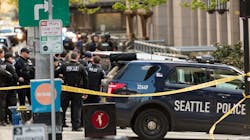Why A Variety Of Rally Points Matters
As an active duty police officer and as a member of the media, I’ve always been aware of the fact that if I’m responding to an active shooter event, where I respond is going to be different. If I’m in uniform, armored up, armed and equipped, I’m responding straight to the incident location expecting to be put to work. If I’m in everyday clothing and not part of the emergency response team, I’m going to the location specified for media representatives to be briefed. Those are not the only two options though, and any command level officer responding to or in charge of managing the situation had better not only be aware of the options but ensure they are covering them all.
First, expect that any responding officers, on or off duty, are coming to be part of the emergency response team, and fully expecting to be making entry to go find and neutralize the shooter(s). If you have enough officers on scene to set up any kind of perimeter then you also have enough to direct incoming officers to a rally point. Whether those officers are volunteers from other agencies, off-duty officers from your own agency or other self-dispatched officers, you need a centralized location they can be directed to and a command level officer at that location to effectively sign them in, verify their credentials and assign them tasks.
Media
Almost any active shooter event at an educational institution, or one with a sufficiently large number of casualties, or one that is on-going just long enough for media representatives to arrive, will garner national attention. A location that is reasonably easy to find, not terribly far from the incident site, but sufficiently spaced away so that it’s not within a direct line of sight (even using magnifying optics) is required. A coordinator for your agency, whether it’s a press information officer, the lowest ranked deputy you have, or simply someone you assign that can direct people to a given place is also required.
Politicians
If an incident occurs and you have media responding, politicians are going to be right behind. While you could simply direct politicians to the media rally point, you would be well advised to direct them to a different location, but one that isn’t far from the media location. You’ll want to put them somewhere they can get a special briefing—even if you’re not telling them anything different from what you’re telling everyone else. After you’ve given them that you’re going to need to coordinate where and when they get in front of the media’s cameras. A simple and efficient way to work this is to assemble the politicians in a location adjacent to the media rally point and then, as you brief them, make a list of those who want camera time. You can let them work out who goes first or you can decide and assign them slots. Doing the latter leaves you in the position of earning their dislike if they feel slighted. That said, most are fairly reasonable and understand the pecking order they are in.
Evac
Parallel with securing the incident location and setting up those other rally points, you’ll also need a place to evacuate non-victims and potential witnesses. If those are students, that location will have to be communicated to parents and organized with whatever bus driver operation your area uses. What you don’t want is the students, staff, faculty, etc. going back into your crime scene. Be cognizant of the desire of the parents to immediately pick up their children and get them home safely. Every parent can understand that motivation, however, some of those students are witnesses and need to be delayed in release long enough to be interviewed by investigators.
Command
Often used to coordinate both response and investigation, the command post needs to be reasonably close to the incident location but also far enough away to avoid being enveloped inside the response area if the incident scene grows. Communication lines available and transportation concerns need to be taken into consideration. It’s important to remember that this command post may have to transition into use for a hostage barricade situation in conjunction with or replacement of the active shooter incident. Take potential needs and requirements into consideration in advance of location selection.
Medical
You’ll need a place for emergency medical services. There is no way to know how long this space will need to be occupied and it certainly needs to be protected from the elements.
There may be other concerns requiring additional rally points or designated areas of response function. Each rally point will have a different level of required manpower and where you have shortages, that will need to be communicated back to the location where responding officers are being signed-in and then given assignments. Not all responding officers need to be put to work or on an assignment immediately. Many will accept that there is sufficient immediate manpower but shift work is being assigned for duties such as perimeter security, evidence protection, dignitary protection, bus escorts, and more.
An active shooter event requires far more than officers responding to the scene, and there will be many different professions / personalities that need to be managed. If you aren’t planning in advance then you are planning to lose control, not to mention potentially angering large groups of people who will be looking to you and your agency for a sense of calm and reassurance.
Download the full 2019 Active Shooter Response Supplement at Officer.com/21081202.
About the Author
Lt. Frank Borelli (ret), Editorial Director
Editorial Director
Lt. Frank Borelli is the Editorial Director for the Officer Media Group. Frank brings 20+ years of writing and editing experience in addition to 40 years of law enforcement operations, administration and training experience to the team.
Frank has had numerous books published which are available on Amazon.com, BarnesAndNoble.com, and other major retail outlets.
If you have any comments or questions, you can contact him via email at [email protected].

